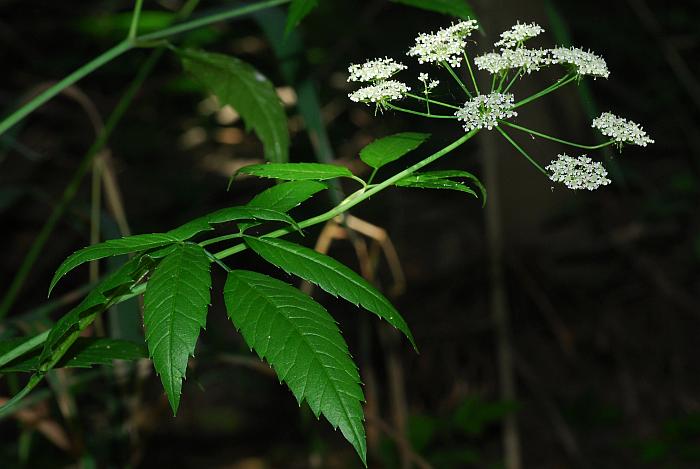Cicuta maculata L.
Common Water Hemlock

Native
CC = 5
CW = -5
MOC = 68
© SRTurner
Cicuta maculata L.Common Water Hemlock | |
 |
Native CC = 5 CW = -5 MOC = 68 |
© SRTurner |
|
Family - Apiaceae Habit - Perennial forb with tuberous-thickened rootstock. Stems - Ascending to erect, to 2 m, glabrous, glaucous, hollow with cross-paritions, sometimes purplish at nodes, simple to branching.
Leaves - Alternate and sometimes basal, glabrous. Lower leaves long-petiolate, the blades to 40 cm long, broadly ovate or triangular-ovate, 2-3x pinnately compound. Upper leaves with shorter petioles, 1-2x pinnately compound or occasionally simple. Leaflets to 12 cm long, lanceolate, tapered at the base, occasionally with basal lobes, the margins sharply toothed, the lateral veins ending at the sinuses between teeth.
Inflorescence - Compound umbels, terminal and axillary, mostly long stalked. Involucre absent or less commonly of 1-4 bracts, these shorter than the rays, spreading to ascending at flowering, linear, with sharply pointed tips. Rays usually numerous, 1.5-6.5 cm long, often unequal in length. Involucel absent or more commonly of 3-7 bractlets, these mostly shorter than the flower stalks, linear to broadly lanceolate, with thin, white, papery margins, tapered to sharply pointed tips.
Flowers - Numerous in each umbellet, on stalks 2-10 mm long. Sepals minute triangular teeth. Petals 5, white, obovate, margins deflexed, to 1.3 mm broad, 1.1 mm long, apiculate and inflexed at apex. Stamens 5, alternating with petals, erect to spreading. Filaments white, 1.2 mm long, glabrous. Anthers whitish, 0.2 mm long. Ovary inferior, 2-locular, glabrous. Styles 2, 0.1 mm long.
Fruits - Schizocarps 2.0-4.5 mm long, broadly oblong-elliptic in outline, flattened laterally, glabrous, dark brown to reddish brown with pale ribs, glabrous, the mericarps with 5 ribs, these blunt and somewhat corky.
Flowering - May - September. Habitat - Sloughs, streambanks, pond margins, wet prairies, other wet areas. Origin - Native to the U.S. Lookalikes - Numerous other members of the Apiaceae (hemlock/carrot family). Other info. - This may be the most toxic vascular plant found in North America. It is fairly common throughout Missouri, and also ranges throughout the U.S. and Canada. The inflorescences appear similar to many other plants in the family. A key feature of this species is the lateral veins of the leaflets, which end at the notches between the teeth rather than at the tips of the teeth. This is clearly visible in the leaflets photo above, and it's a good character for identification. Note that the bracts subtending both the main umbel and the umbellets can be either present or absent. Photographs taken off Hwy H, Shannon County, MO., 6-23-04 (DETenaglia); also at Shaw Nature Reserve, Franklin County, MO, 6-30-2008 and 8-28-2021, Otter Slough Conservation Area, Stoddard County, MO, 7-18-2009, and Busch Wildlife Area, St. Charles County, MO, 7-18-2013, and Pacific Palisades Conservation Area, St. Louis County, MO, 7-23-2020 (SRTurner). |